Nissan Maxima Service and Repair Manual: Side air bag module
Removal and Installation
SEAT ASSEMBLY WITH SIDE AIR BAG MODULE
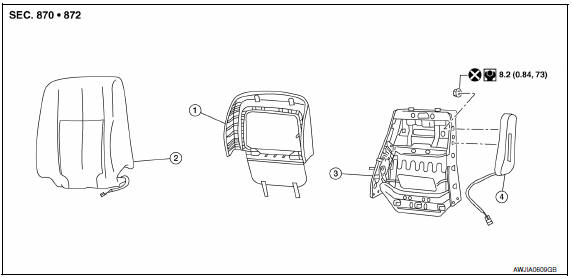
- Seatback board
- Seatback assembly
- Seatback frame
- Side air bag module
WARNING: Do not leave any objects (screwdrivers, tools, etc.) on the seat during seatback repair. It can lead to personal injury if the side air bag should accidentally deploy.
CAUTION:
- Before servicing, turn ignition switch OFF, disconnect both battery terminals and wait at least three minutes.
- Handle the side air bag module carefully. During disassembly, always hold the side air bag module, do not let it hang by the wire harness.
- Always place side air bag module with the stud bolt side facing downward.
- Always work from the side or back of the seatback assembly, do not work in front of seat.
- Do not use air tools or electric tools when servicing the seat assembly.
- Replace the side air bag module if it has been dropped or sustained an impact.
- Do not insert any objects into the side air bag module.
- Do not disassemble the side air bag module.
- Do not expose the side air bag module to temperatures exceeding 93C (200F).
- Do not expose the side air bag module to any oil, grease or water.
- During disassembly, do not damage the trim cover, chutes, harness connectors, retainers, clips, module harness or the side air bag module.
NOTE: If the vehicle has been involved in a collision and the side air bag has deployed, the front seatback assembly must be replaced.
DISASSEMBLY
- Remove the front seat assembly. Refer to SE-68, "Removal and Installation" (WITH CLIMATE CONTROLLED SEATS) or SE-126, "Removal and Installation" (W/O CLIMATE CONTROLLED SEATS).
- Remove the seatback board as follows:
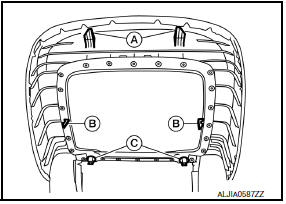
NOTE: The seatback board is attached to the seat frame with the following:
- Two top hooks (A)
- Two side hooks (B)
- Two bottom retainers (C)
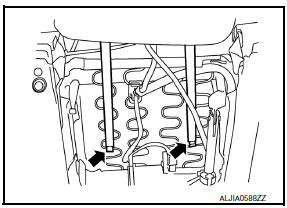
- From the bottom of the seat, unhook the two seat skirt hooks as shown.
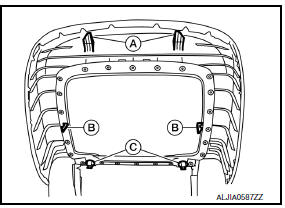
- Carefully pull upward on the lower seatback board to release the two
bottom retainers (C).
- Do not pull outward at two top hooks (A)
- Hold the seatback board at the side hook locations and push in the side hooks (B) to release them from the seatback frame, then pull it rearward.
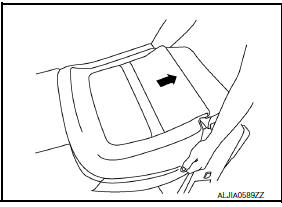
- Carefully pull the seatback board downward to disengage the top hooks as shown.
CAUTION: Use care not to break the seatback board hooks and retainers.
Replace seatback board if any hooks or retainers are damaged.
- If equipped with climate controlled seats, disconnect the climate control seat duct.
- Remove and discard the two chute rod bolts (A), then remove the chute rod (1).
CAUTION: Do not reuse the chute rod bolts.
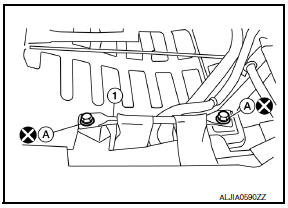
Chute rod bolts (A) : 8.2 N*m (0.84 kg-m, 73 in-lb)
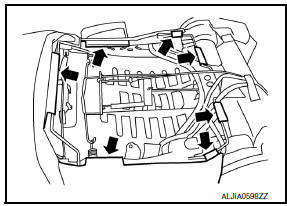
- Release the seven seatback retainers from the seatback frame as shown.
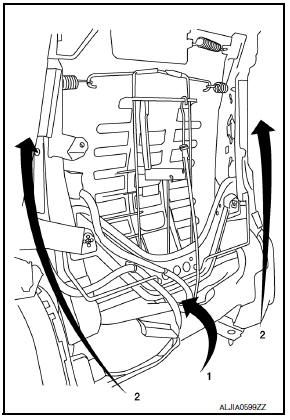
- Push the seatback trim and foam pad forward at the bottom (1), then holding the seatback assembly on both sides, lift upward (2). Move the seatback trim and foam pad forward enough to access the side air bag module.
- Disconnect the side air bag module harness clips from the seat frame as shown.
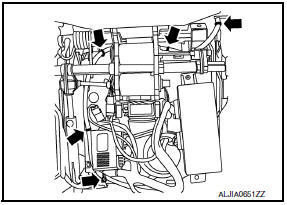
- Front LH climate controlled seat
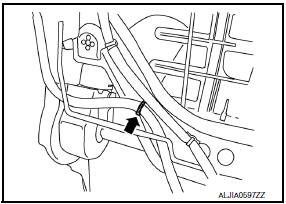
- Remove side air bag module harness clips from seat frame (arrows).
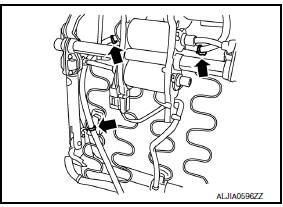
- Front LH without climate controlled seat
- Remove side air bag module harness clips from seat frame (arrows).
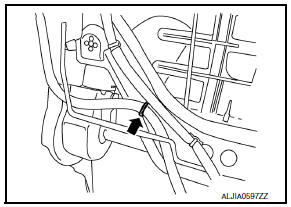
- Front RH seat
- Remove side air bag module harness clips from seat frame (arrows).
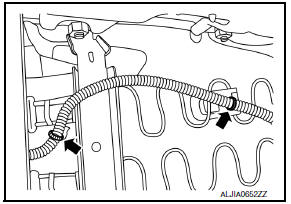
- Disconnect the harness connector from the side air bag.
- Remove and discard the two side air bag module nuts (1), then remove the side air bag module.
CAUTION: Do not reuse the side air bag module nuts.
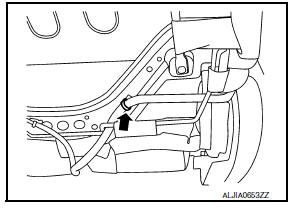
Air bag module nuts (1) : 8.2 N*m (0.84 kg-m, 73 in-lb)
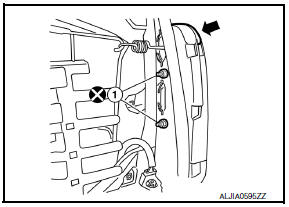
ASSEMBLY
Assembly is in the reverse order of disassembly. During assembly, note the following.
- Make sure the chute rod is properly positioned and installed as
shown.
 : Front
: Front

- Make sure the side air bag outer chute (7) is pulled over the side air bag module (3) and the side air bag inner chute (4) is pulled around the frame (2). Make sure there are no wrinkles and the chutes are not folded, twisted or pinched.
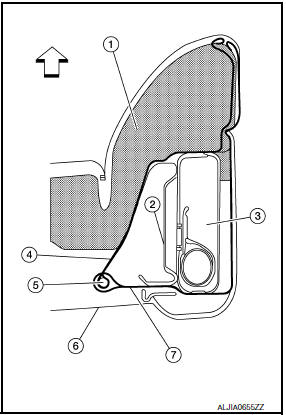
- Seatback pad
- Frame
- Side air bag module
- Inner side air bag chute
- Chute rod
- Seatback board
- Outer chute
 : Front
: Front
CAUTION:
- If a malfunction was detected by the air bag warning lamp, after repair or replacement of the malfunction parts, reset the memory using self-diagnosis or CONSULT.
- After work is completed, check that no system malfunction is detected by air bag warning lamp.
- Make sure side air bag module shell is closed at all tabs and cushion of module is not exposed. Do not reuse if the tab of shell is not secured.
- Always install new side air bag module attaching nuts and side air bag chute rod bolts.
- Always route side air bag module harness in original location. Replace any deformed or damaged clips with the same type and color. Always install clips in the original location on the harness.
- Smooth out all wrinkles during assembly.
- Inspect seatback cushion, trim cover and trim cover chutes. Replace any damaged parts.
- Replace any deformed or damaged parts.
 Side curtain air bag module
Side curtain air bag module
Component
Side curtain air bag module tether
Side curtain air bag module assembly
Side curtain air bag module inflator
Front
Removal and Installation
CAUTION:
Before servicing ...
 Crash zone sensor
Crash zone sensor
Component
Crash zone sensor harness connector
Crash zone sensor
Nut
Front
Removal and Installation
CAUTION:
Before servicing, turn ignition switch OFF, disconnect both
bat ...
Other materials:
Vehicle speed signal circuit
Description
Combination meter sends vehicle speed signal to power steering control unit.
Diagnosis Procedure
1.PERFORM COMBINATION METER SELF-DIAGNOSIS
Perform combination meter self-diagnosis.
2.CHECK HARNESS BETWEEN COMBINATION METER AND POWER STEERING CONTROL UNIT FOR
OPEN
Turn the ...
Extended storage switch
The extended storage switch is used when the
vehicle is in transit from the factory. It is located in
the fuse panel to the left of the steering wheel on
the instrument panel. If any electrical equipment
does not operate, ensure the extended storage
switch is pushed fully in place, as shown ...
Installing front license plate
Use the following steps to mount the front license
plate:
1. Make holes on the plastic finisher at the
location mark (small dimple) using a 5 mm
(0.20 in) drill. Apply light pressure to the drill.
Install the license plate holder using the two
screws provided with the holder.
2. Mount ...
Nissan Maxima Owners Manual
- Illustrated table of contents
- Safety-Seats, seat belts and supplemental restraint system
- Instruments and controls
- Pre-driving checks and adjustments
- Monitor, climate, audio, phone and voice recognition systems
- Starting and driving
- In case of emergency
- Appearance and care
- Do-it-yourself
- Maintenance and schedules
- Technical and consumer information
Nissan Maxima Service and Repair Manual
0.0062
